Eddy currents
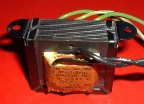
Under the influence of these etc. c. in the mass of the metal part eddy currents (Foucault currents), which are enclosed in the mass, forming eddy current chains.
Eddy currents (also Foucault currents) are electric currents that arise as a result of electromagnetic induction in a conductive medium (usually a metal) when the magnetic flux passing through it changes.
Eddy currents generate their own magnetic fluxes, which through Lenz's rule, oppose the magnetic flux of the coil and weaken it. They also cause core heating, which is a waste of energy.
Let it have a core made of metallic material. We put a coil on this core, along which we pass alternating current… Around the coil there will be an alternating magnetic current crossing the core.In this case, an induced EMF will be induced in the core, which in turn causes currents in the core called eddy currents. These eddy currents heat the core. Since the electrical resistance of the core is low, the induced currents induced in the cores can be quite large and the heating of the core can be considerable.
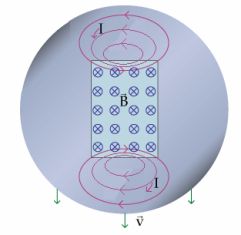
The emergence of Foucault currents (eddy currents)
Eddy currents were first discovered by the French scientist D.F. Arago (1786 — 1853) in 1824 in a copper disc located on an axis under a rotating magnetic needle. Due to eddy currents, the disc began to rotate. This phenomenon, called the Arago phenomenon, was explained a few years later by M. Faraday from the position of the law of electromagnetic induction.
Eddy currents were studied in detail by the French physicist Foucault (1819 - 1868) and are named after him. He called the phenomenon of heating of metal bodies rotating in a magnetic field, eddy currents.
V as an example in Fig. uncovered shows eddy currents induced in a massive core placed in an AC coil. An alternating magnetic field induces currents that are closed along paths lying in planes perpendicular to the direction of the field.
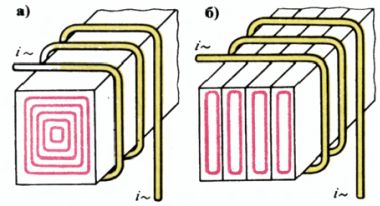
Eddy currents: a — in a massive core, b — in a lamellar core
Ways to reduce Foucault currents
The power consumed for heating the core by eddy currents uselessly reduces the efficiency of technical devices of the electromagnetic type.
To reduce the power of the eddy currents, the electrical resistance of the magnetic circuit is increased; for this, the cores are collected from separate thin (0.1-0.5 mm) plates, isolated from each other using a special varnish or rock.
The magnetic cores of all alternating current machines and devices and the armature cores of direct current machines are assembled from varnished or surface non-conductive film (phosphate) plates, insulated from each other, stamped from sheet electrical steel. The plane of the plates must be parallel to the direction of the magnetic flux.
With such a separation of the cross-section of the core of the magnetic circuit, the eddy currents are significantly weakened, since the magnetic fluxes that block the eddy current loops are reduced, and therefore the emf induced by these currents is also reduced. etc. with the creation of eddy currents.
Special additives are also introduced into the core material, which also increase it. electrical resistance. To increase the electrical resistance of a ferromagnet, electrical steel is prepared with a silicon additive.
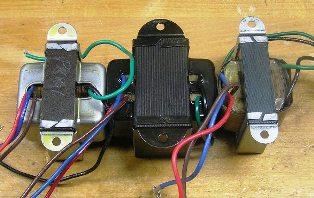
Lined magnetic circuit of the transformer
The cores of some coils (coils) are drawn from pieces of red-hot iron wire. The iron strips are placed parallel to the lines of magnetic flux. Eddy currents flowing in planes perpendicular to the magnetic flux direction are limited by insulating seals. Magnetodielectrics are used for magnetic cores of devices and devices operating at high frequency. In order to reduce eddy currents in the wires, the latter are made in the form of a bundle of individual wires, isolated from each other.
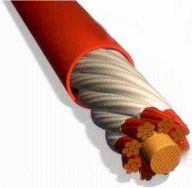
A lysendrat is a system of braided copper wires in which each core is isolated from its neighbors. The face conductor is designed for use with high frequency currents to prevent stray currents and Foucault currents from occurring.
Application of Foucault currents
In some cases, eddy currents are used in technology, for example to stop rotating massive parts. The electromotive force induced in the elements of the workpiece when crossing the magnetic field causes closed currents in its thickness, which, interacting with the magnetic field, create significant counter moments.
Such magneto-inductive braking is also widely used to calm the movement of moving parts of electric meters, in particular to create a counter-torque and stop the moving part of electricity meters.
In these devices, a disk mounted on the axis of the counter rotates in the gap of a permanent magnet. Eddy currents induced in the disk mass during this motion, interacting with the flux of the same magnet, create opposing and braking torques.
For example, eddy currents have been detected in the magnetic brake device of an electric meter disk. Rotation, the disc intersects permanent magnet magnetic field lines… Eddy currents arise in the plane of the disk, which in turn create their own magnetic fluxes in the form of tubes around the eddy current. Interacting with the main field of the magnet, these fluxes decelerate the disk.
In some cases, with the help of eddy currents, it is possible to use technological operations that cannot be implemented without high-frequency currents. For example, in the manufacture of vacuum devices and devices, it is necessary to carefully evacuate air and other gases from a cylinder. However, there is residual gas in the metal fittings inside the cylinder, which can only be removed after the cylinder is boiled.
For complete degassing of the armature, a vacuum device is placed in the field of a high-frequency generator, as a result of the action of eddy currents, the armature is heated to hundreds of degrees, until the remaining gas is neutralized.
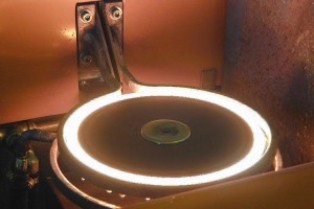 The use of eddy currents in the induction hardening of metals
The use of eddy currents in the induction hardening of metals
An example of a useful application of alternating field eddy currents is electric induction furnaces… In these, a high-frequency magnetic field created by a coil that surrounds the crucible induces eddy currents in the metal in the crucible. The energy of the eddy currents is transformed into heat that melts the metal.
